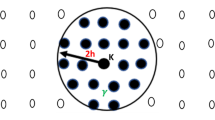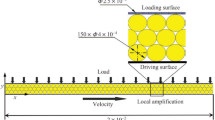Abstract
The reliable and precise machining of cylinder head components in the combustion engine represents a crucial and complicated step in the production process. In industrial manufacturing processes, disturbances are inevitable and provide a measure of uncertainty in each production step. Increasingly, the influence of such uncertainties is being evaluated using simulation models. To determine the performance quality of the model, a suitable cutting material and the edge geometry must be identified. In this paper, experimental investigation of polycrystalline cubic boron nitride grades for machining valve seats made of powder metallurgy steel in a combustion engine is presented. Then, a mechanistic approach is used to establish a prediction model of the process forces based on the experimentally determined data set.









Similar content being viewed by others
Abbreviations
- A:
-
Cross-secion of undeformed chip (mm2)
- ap :
-
Depth of cut (mm)
- b:
-
Width of undeformed chip (mm)
- f:
-
Feed per rev. (mm/rev)
- Fc :
-
Cutting force (N)
- Ff :
-
Feed force (N)
- Fp :
-
Passive force (N)
- Fr :
-
Radial force (N)
- Kc :
-
Specific cutting force (N/mm2)
- Kf :
-
Specific feed force (N/mm2)
- Kp :
-
Specific passive force (N/mm2)
- t:
-
Time (s)
- V:
-
Material removal volume (cm3)
- VB:
-
Width of flank wear-land (μm)
- vc :
-
Cutting speed (m/min)
- β:
-
Regression coefficient (-)
- γ:
-
Working rake angle (°)
- κ:
-
Tool edge angle (°)
References
van Basshuysen R, Schäfer F (eds) (2012) Handbuch Verbrennungsmotor—Grundlagen, Komponenten, Systeme, Perspektiven. Vieweg-Verlag, Wiesbaden
Jesus Filho ES et al (2005) P/M valve seat inserts: machinability and mechanical characterisation. No. 2005-01-0717. SAE technical paper
Abele E, Bölling C (2014) Modellierung der geometrischen Eingriffsbedingungen bei der Ventilsitzbearbeitung am Zylinderkopf. Werkstattstechnik online 11/12:735–740
Li Y et al (2000) Force modeling for cylindrical plunge cutting. Int J Adv Manuf Technol 16:863–870
Klocke F, Brinksmeier E, Weinert K (2005) Capability profile of hard cutting and grinding processes. CIRP Ann Manuf Technol 54(2):22–45
Mahle GmbH (2013) Ventiltrieb. Systeme und komponenten. Vieweg-Verlag, Wiesbaden
Trent EM, Paul KW (2000) Metal cutting, 4th edn. Butterworth-Heinemann, Boston
Saketi S, Sveen S, Gunnarsson S, M’Saoubi R, Olsson M (2015) Wear of a high cBN content PCBN cutting tool during hard milling of powder metallurgy cold work tool steels. Wear 332–333:752–761
M’Saoubi R et al (2013) Wear mechanisms of PVD-coated PCBN cutting tools. Wear 302:1219–1229
M’Saoubi R et al (2014) Machinability of powder metallurgy steels using PcBN inserts. Procedia CIRP 14:83–88
Dogra M et al (2011) Tool life and surface integrity issues in continuous and interrupted finish hard turning with coated carbide and CBN tools. Proc IMechE Part B J Eng Manuf 226:431–444
Angseryd J, Andrén H-O (2011) An in-depth investigation of the cutting speed impact on the degraded microstructure of worn PCBN cutting tools. Wear 271:2610–2618
Uhlmann E et al (2009) Machining of high performance workpiece materials with cBN coated cutting tools. Thin Solid Films 518:1451–1454
Ventura CEH et al (2013) Cutting edge preparation of PCBN inserts by means of grinding and its application in hard turning. CIRP J Manuf Sci Technol 6:246–263
Baizeau T et al (2015) Effect of rake angle on strain field during orthogonal cutting of hardened steel with c-BN tools. Procedia CIRP 31:166–171
Rocha CA et al (2004) Evaluation of wear mechanisms and surface parameters when machining internal combustion engine valve seats using PCBN tools. J Mater Process Technol 145:397–406
Lacerda HB, Siqueira IL (2012) Blade geometry effects on the boring of valve seats of internal combustion engines. Int J Adv Manuf Technol 63:269
Hu B et al (2008) Performance characteristics of a newly developed machinability additive for PM applications. Adv Powder Metall Part Mater 1–12
Aouici H et al (2012) Analysis of surface roughness and cutting force components in hard turning with CBN tool: prediction model and cutting conditions optimization. Measurement 45:344–353
Özel T et al (2008) Hard turning with variable micro-geometry PcBN tools. CIRP Ann Manuf Technol 57:73–76
Klocke F, Kratz H (2005) Advanced tool edge geometry for high precision hard turning. CIRP Ann Manuf Technol 54(1):47–50
Camargo JC, Dominquez DS, Ezugwu EO, Machado AR (2014) Wear model in turning of hardened steel with PCBN tool. Int J Refract Metals Hard Mater 47:61–70
Koenigsberger F, Sabberwal, AJP (1961) An investigation into the cutting force pulsations during miling operations. Int J MTDR 1:15–33
Ehmann KF et al (1997) Machining process modeling: a review. J Manuf Sci Eng 199:655–663
Kaymakci M, Kilic ZM, Altintas Y (2012) Unified cutting force model for turning, boring, drilling and milling operations. Int J Mach Tools Manuf 54:34–45
Jefcott H (1919) The lateral vibration of loaded shafts in the neighborhood of a wirling speed-the effect of want of balance. Phil Mag 37/6:304–314
Föppl A (1895) Das Problem der laval’schen Turbinenwelle. Civilingenieur 41:332–342
Grzesik W et al (2013) A new mechanistic friction model for the oblique cutting with tool wear effect. Tribol Int 66:49–53
Acknowledgements
The authors would like to thank the German Research Foundation (DFG) for funding the research activities at the Collaborative Research Centre (CRC) 805 Control of Uncertainty in Load-Carrying Structures in Mechanical Engineering. Tools were supplied by Kennametal within the framework of the project.
Author information
Authors and Affiliations
Corresponding author
Rights and permissions
About this article
Cite this article
Bölling, C., Kuhne, M. & Abele, E. Modeling of process forces with consideration of tool wear for machining of sintered steel alloy for application to valve seat in a combustion engine. Prod. Eng. Res. Devel. 11, 477–485 (2017). https://doi.org/10.1007/s11740-017-0759-y
Received:
Accepted:
Published:
Issue Date:
DOI: https://doi.org/10.1007/s11740-017-0759-y




